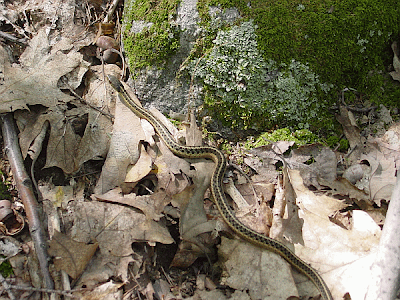Thamnophis sauritus - Eastern Ribbon Snake
or
Thamnophis sirtalis- Eastern Garter Snake
Why two identifications? I am not really sure which it is.
These snakes are very common in my neck of the woods (the picture was taken in a firewood pile next door to where I live in the mid-Hudson Valley of New York). Despite the threatening position, they're completely harmless (I even owned a captured one as a pet for a summer when I was a kid - my mother made me keep the aquarium outside!). They swim well and I've often seen them eating small frogs although they'll eat just about anything they can swallow whole. This one probably ate recently as witnessed by the slight bulge a couple of inches below its head.
According to Nearctica, the identifying characteristics of ribbon snakes are:
Snake 18 to 40 inches in length. Tail elongate and slender, comprising nearly one-third of the length of the snake. No fused dark spots present on the crown of the head. Body with a light yellow to white dorsal stripe and a yellow to white lateral stripe on both sides of the body. Lateral stripe located on the 3rd and 4th scale rows. Underside of head and belly white. Belly with a dark brown stripe along each of the outer margins. Dorsal body scales keeled and anal plate single.
I think it's a ribbon snake (although I didn't examine for a single anal plate!) but not 100% sure. Here's another seen while hiking at the Mohonk Preserve in the Shawangunks in the fall.
Characters in common include usually the presence of a dorsal and lateral stripes. Lateral stripes are located on the 2nd and 3rd scale rows. Head usually with 7 labial scales. Dorsal scales keeled and anal plate single... Midline and lateral lines usually yellow; lateral area between midline and lateral line usually gray-brown with a double row of alternating; coloration, however, individually variable.
Clearly they're both Thamnophis sp. but I can't really identify them with more certainty - I'd need to examine two snakes, one from each species, at the same time, I'm thinking, to be able to really tell them apart. I'm guessing one of the more distinctive features would be that the lateral stripes in ribbon snakes are 3rd & 4th scale rows while on the garter snake they're on the 2nd & 3rd scale rows. Problem is, when I look at the coiled guy, I think I see something like five rows of alternating scales between the midline and the lateral line! The description for the garter snake does say there's a "double row of alternating" (alternating what?) between the midline and lateral lines. There is an double alternating pattern of darker dots on both (fainter on the coiled guy, but it's there). Maybe they're both garter snakes then.
Can anyone give helpful suggestions on how to tell them apart next time I see them? I think I will grab one and look at it more closely.




Hi,
ReplyDeleteBoth of the photos you have posted are definitely the Eastern Garter Snake (Thamnophis sirtalis).
Let's see...Eastern Garter Snakes have a much more distinct checkered pattern, which is present, but usually not nearly as obvious on Eastern Ribbon Snakes (Thamnophis sauritus). Eastern Ribbon Snakes usually have a very high contrast between their stripes, with very light yellow and almost black stripes on the back...below the yellow side stripes on an Eastern Ribbon Snake, there is a clearly brown stripe above the light belly, so, going around an Eastern Ribbon Snake basically goes as follows: light yellowish belly, brown lower side stripe, yellow side stripe, dark side stripe (black to brown, and sometimes with some checkering), yellow mid-dorsal stripe, repeat in reverse to belly. Ribbon Snakes are typically much more slender, and finally have an almost white color below the eye, on the lower half of the head, very distinctly.
Eastern Garter Snakes are variable, but are clearly thicker, and almost always have a distinct checkering pattern on the sides of the back. Eastern Garter Snakes do not have a distinct brown stripe on the lower sides, and do not have an almost white color on the lower sides of the head, as do the ribbons. Overall, the light and dark stripes of the Eastern Garter Snake do not display as much contrast.
-Chris Mallery